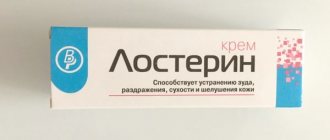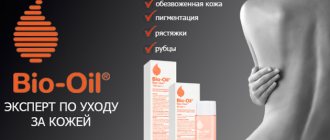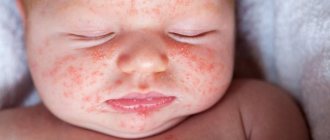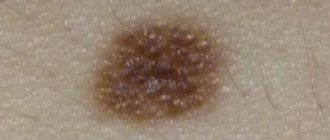The article was prepared by a specialist for informational purposes only. We urge you not to self-medicate. When the first symptoms appear, consult a doctor.
Diathesis
– this is a child’s hereditary predisposition to various allergic reactions, respiratory infections, acid-base metabolism disorders, etc.
If we turn to the Greek language, the word “diathesis” is translated as “inclination.” Modern medicine does not consider diathesis as a disease. It is equated to special conditions that develop in childhood.
The main characteristics of this disorder:
- Diathesis has a hereditary predisposition.
- It is characterized by a wave-like flow. From time to time, exacerbations of diathesis occur.
- Diathesis often develops in children who suffer from allergies, acute respiratory viral infections, seizures, metabolic disorders, and immunological pathologies.
The favorite place for diathesis to manifest itself is children's cheeks.
What does diathesis lead to?
If an exacerbation is not treated in time, the child’s allergic diathesis can become chronic.
In addition, allergic diathesis is the first stage of the atopic march. The atopic march is the sequential development in the same child of first atopic dermatitis, then allergic rhinitis, and by the age of 5-6 years - bronchial asthma. Therefore, the outcome of the entire atopic disease, in particular the development of bronchial asthma, largely depends on the treatment tactics of atopic dermatitis.
How to recognize atopic dermatitis in time?
Clinical manifestations of atopic dermatitis - food allergies - can be as follows:
- Allergic skin lesions: the skin becomes dry, redness, rashes, peeling, cracks, weeping appear - these manifestations are localized on the skin of the cheeks, forehead, neck and scalp, and later the process is localized in the area of the extensor and flexion surfaces of the joints;
- Atopic dermatitis is often combined with gastrointestinal disorders (regurgitation, nausea, vomiting, colic, flatulence, diarrhea, constipation, unstable stool), acute respiratory viral infections, obstructive syndrome, allergic rhinitis.
At the first such symptoms, you should immediately consult a doctor.
What to do if symptoms of diathesis appear?
Nursing mothers should remember that when symptoms of diathesis appear in infants, they themselves need to follow a diet and exclude from their diet foods the consumption of which leads to an exacerbation of the disease. It must be remembered that restricting the diet is not an end in itself. Products are excluded for a time; if their exclusion leads to improvement in the child, then a conclusion is drawn about the connection of such products with an allergic reaction and vice versa. If it turns out that excluding a product does not affect the course of the disease, then there is no point in limiting yourself.
Products with varying levels of allergenic potential:
- The following have a high allergenic potential: whole cow's milk; eggs; caviar; wheat, rye; carrots, tomatoes, bell peppers, celery; strawberries, wild strawberries, raspberries; citrus fruits, pineapples, pomegranates, kiwi, mango, persimmon, melon; coffee, cocoa; chocolate; mushrooms; nuts; honey;
- Average allergenic potential: beef; buckwheat, oats, rice; peas, beans, soybeans; potatoes, beets; peaches, apricots, cranberries, lingonberries, cherries, blueberries, black currants, rose hips, bananas;
- Low allergenic potential: fermented milk products; horse meat, rabbit meat, turkey, lean pork, lean lamb; cauliflower, white cabbage, broccoli, zucchini, squash, cucumbers; green varieties of apples and pears, white and red currants, white and yellow cherries, yellow varieties of plums; garden greens (parsley, dill);
If the child is bottle-fed, then special food is selected for children with allergies. If the child has already begun to be given complementary foods, then you should remove foods that can cause food allergies one by one, so as not to remove excess foods. It should be remembered that unreasonable dietary restrictions, especially long-term ones, can lead to disturbances in the development of the body.
Treatment with drugs
A child with diathesis is prescribed antihistamines:
- 1st generation allergy medications have a sedative effect on the body. Therefore, they are used when the baby is excessively restless, suffers from sleep disturbances, and cries a lot. The drugs are prescribed for a period of up to 14 days. They are changed every 5 days. Such medicines include: Suprastin, Pipolfen, Tavegil.
- 2nd generation allergy treatments. They quickly relieve allergy symptoms, but do not have a hypnotic effect. Therefore, you can take them for several weeks. Such drugs include: Zyrtec, Elastin, Claritin.
Sedatives are prescribed if the child is too restless or crying.
Probiotics are indicated for use when a child is diagnosed with dysbiosis. They are prescribed courses. For this purpose, Bifidumbacterin, Linex, Normobact, etc. can be used.
Many doctors question the use of immunomodulators. In infants, the immune system in any case does not differ in maturity. While additional drug load can lead to a weakening of defenses and can become a trigger for autoimmune processes.
How to relieve exacerbation of diathesis?
You can prevent the development of an allergic reaction if you immediately take Enterosgel. The drug removes allergens and toxic substances, avoiding the use of excess medications. You should adhere to a hypoallergenic diet.
If the symptoms of diathesis have not disappeared, you need to consult a doctor who will supplement the treatment with external, anti-inflammatory and antihistamine drugs.
Enterosgel is the only enterosorbent that is officially recommended for children from the first days of life. Kazan and Moscow Pediatric Schools and Allergy Centers in Russia and the CIS and Far Abroad (from New Zealand to Great Britain) widely use Enterosgel for allergic dermatoses in clinical settings.
Recommended regimen for using Enterosgel during exacerbation
- First of all, nursing mothers are recommended to take Enterosgel internally themselves to improve the quality of milk (1 tablespoon three times a day);
- A child under one year of age is given Enterosgel (paste) without the “sweet” label immediately before meals, before each feeding;
- For infants up to 6 months: add 2/3 of water or breast milk to 1/3 teaspoon of Enterosgel paste and give before each feeding;
- For children under one year of age Enterosgel: 1/2 teaspoon + ½ teaspoon of water, also before each feeding;
- After a year, Enterosgel is usually given simply 1-2 teaspoons three times a day, added to fruit puree;
- Locally, when it gets wet, periodically apply Enterosgel, diluted with 1/3 of the Tsindol mash, to the affected areas, and alternate this procedure with conventional local remedies.
Local treatment of diathesis
If a child suffers from acute diathesis, then he needs to be bathed once a day. Features of the procedure:
- The bath time is 10 minutes.
- If a child has weeping eczema, then you need to add potassium permanganate to the water so that it becomes a faint pink color.
- If a child has diaper rash, then add an infusion of string or sage to the water. You can use starch. To prepare the infusion, take a tablespoon of herb per glass of water (holding time is 20 minutes). Before adding the infusion to the bath, you need to strain the composition.
- Starch (2 tablespoons) is dissolved in 50 grams of cold water, then 2 cups of boiling water are added to it and poured into the bath.
After the procedure, the child’s skin folds are lubricated with vegetable oil. It is pre-boiled and cooled.
You can also use the following tools:
- Lotions with Furacilin solution. You will need half a tablet per glass of water. The lotions are left on the child’s skin until the redness goes away. It is important to ensure that the cotton swab does not dry out.
- Lotions with soda that help get rid of itchy skin. Take a teaspoon of soda per glass of water. It is forbidden to rub the baby's skin. Cotton wool soaked in the solution is simply applied to the baby’s skin.
- Baby oil and baby cream can be used in areas of excessive flaking of the skin.
- Ointments for diathesis. Such remedies can only eliminate the visible manifestations of the disorder, but they are not able to cope with the cause of the problem.
Many creams and ointments for diathesis have contraindications and side effects. They should not be used without medical advice.
Non-hormonal ointments:
- Guzhienko paste with zinc and diphenhydramine. It is made to order in a pharmacy.
- Elidel. The ointment can be used starting from three months of age. The drug is gently rubbed into the skin 3 times a day.
- Fenistil gel. It can be used from one month of age. Apply the product to the skin 3 times a day in a thin layer.
- Bepanthen ointment. It is applied to the dermis 2 times a day.
- La-cree. The drug contains panthenol, walnut extract, string, licorice and bisabolol.
- Tsindol. A preparation based on zinc oxide.
- Desitin with zinc oxide.
If bacterial inflammation develops on the skin, then you can use Vishnevsky ointment, Levomekol, Xeroform in the form of a powder.
Recommended regimen for using Enterosgel for prevention
Prophylactic administration of Enterosgel is usually carried out twice a day, in the morning and at night, in the dosages indicated above and in the manner described. If no exacerbation occurs within a month, you can stop taking Enterosgel prophylactically.
Locally, to care for “problem” areas (perineum, natural folds), Enterosgel is used once a day, usually before putting on a diaper at night or before an air bath. The diaper area is treated with Enterosgel mixed 1:1 with water (applied simply with the palms of the mother).
- Diet for diathesis;
- Treatment of diathesis in infants;
- Treatment of diathesis in children;
- Treatment of diathesis in newborns.
Why does the anomaly develop?
Among the causes of diathesis, doctors name a number of hereditary and prenatal factors, environmental features and care for the newborn. Among them:
- complications of pregnancy - toxicosis, infections suffered by the mother during pregnancy, taking certain medications during pregnancy, bad habits and eating disorders, fetal hypoxia;
- unfavorable heredity, the presence of anomalies in close relatives;
- too small or increased body weight of the child at birth;
- perinatal pathologies of the central nervous system;
- artificial feeding;
- dysbacteriosis;
- improper child care, temperature irregularities or poor nutrition;
- vaccination;
- chronic infections;
- emotional distress.
The mechanism of formation of physiological adaptation of a newborn is quite complex and fragile, it is influenced by many factors.
What is diathesis: a disease or a reaction of the body?
Translated from Greek, the word “diathesis” means a tendency, a predisposition to something. Diathesis cannot be regarded as a disease. It is more correct to consider it a hereditary predisposition of the body, an inadequate response to certain factors, for example, food.
Each of us inherited from our parents a whole “genetic archive”, for example, eye color, nose shape, predisposition to allergies or an ear for music.
The tendency to diseases is realized when the body is exposed to various unfavorable factors: stress, bad habits, polluted environment, unhealthy diet, occupational hazards.
Since predispositions are different, scientists have described various diathesis. The most common are exudative-catarrhal diathesis, lymphatic-hypoplastic and neuro-arthritic, also known as uric acid diathesis.
Hemorrhagic and salt diathesis are considered as separate diseases. Hemorrhagic refers to blood diseases, and saline refers to metabolic diseases.
Forecast
If all measures to prevent diathesis are followed in full, then the disorder can be overcome by 2-4 years. The child ceases to suffer from allergies to those substances that previously caused an inflammatory reaction in him. He will begin to tolerate cow's milk protein, eggs and fruit.
If diathesis cannot be brought under control and the disease worsens all the time, then in the future this threatens the development of allergies and immunodeficiency.
If there are cases of diathesis in the family, then prevention of the disorder should begin during pregnancy. A woman should exclude allergic foods from her diet. Smoking is prohibited during pregnancy. This bad habit not only increases the likelihood of developing diathesis, but also other serious diseases.
Author of the article:
Sokolova Praskovya Fedorovna |
Pediatrician Education: Diploma in general medicine received from Volgograd State Medical University. Immediately received a specialist certificate in 2014. Our authors
Exudative-catarrhal diathesis
“Owners” of allergic or exudative-catarrhal diathesis are predisposed to infectious diseases and allergies.
The following factors provoke exudative diathesis:
- unfavorable course of pregnancy (toxicosis, infections);
- genetic predisposition (the child’s parents are allergic);
- smoking matter;
- maternal nutrition during breastfeeding;
- complications after childbirth (birth trauma, fetal hypoxia);
- unfavorable living conditions, industrial hazards;
- medications, household chemicals and other potential allergens.
Often, babies under one year old are bothered by exudative diathesis; they cry and sleep poorly due to itchy skin.
Pets can also become “culprits” of exudative diathesis: cats, dogs, hamsters.
Exudative-catarrhal diathesis can manifest itself in different ways.
Atopic diathesis: the child develops redness, dry skin, pimples, peeling or diaper rash on the cheeks.
Allergic diathesis on the face can be a harbinger of allergic rhinitis and bronchial asthma.
The mucous membrane of the eye also often becomes a target for exudative-catarrhal diathesis. The patient is concerned about itching, lacrimation, swelling and redness of the conjunctiva, and photophobia.
Early detection and timely treatment of diathesis will prevent the development of autoimmune and allergic processes.
Food allergens that provoke exudative-catarrhal diathesis can cause enterocolitis. The mother notices that the child has bloating, diarrhea or constipation, and regurgitation of food. Older children with exudative-catarrhal diathesis report pain in the navel and nausea.
Breastfeeding mothers should remember: diathesis has appeared in infants - it’s time to “go on” a strict diet.
Diathesis in newborns who are on artificial nutrition involves the selection of special hypoallergenic mixtures, and when administering complementary feeding, the exclusion of potential food allergens.
For inflammation of the skin, pediatricians prescribe special lotions and ointments for diathesis.
Exudative diathesis in adults is usually called atopic dermatitis. Quite often, allergies in adults (hay fever, food allergies, asthma) can originate from childhood. That is, a consequence of exudative-catarrhal diathesis.
Diathesis in newborns during breastfeeding
Skin rashes in children under one year of age are determined by heredity, nutrition and care conditions. Diathesis in newborns as inflammation of the skin on the face or hands is one of the manifestations of an allergic reaction. When is a baby more likely to develop diathesis, what are the consequences of an advanced condition and how to prevent the development of diathesis in an infant thanks to a diet that includes “goat” formula, explains Ph.D., doctor of the highest category, pediatrician and deputy head of the children's hospital on Savelovskaya Alla Anatolyevna Shcherbakova.
— Alla Anatolyevna, diathesis occurs with surprising frequency in infants. What is this anomaly and why does diathesis occur at a very early age, in newborns?
— Diathesis is a word of Greek origin, which from a doctor’s point of view means a hereditary predisposition to the development of certain pathological conditions. In a routine sense, diathesis is a rash on the skin of a child in infancy (atopic dermatitis).
The newborn period lasts the first 28 days of life, after which the child is called an infant. The debut of diathesis in the form of an inflammatory condition of the skin most often occurs in the transition period from newborn to infancy - at 3-5 weeks.
Diathesis is not a diagnosis, but a predisposition of the body of young children to allergic reactions. The most common form of allergic diathesis is atopic dermatitis (food allergy). In 99% of cases it is detected in the first three months of life. Other forms of dermatitis in children - diaper, contact, seborrheic - also often appear in early infancy.
— How does diathesis manifest in infants and how to distinguish diathesis from allergies?
- Rashes on the cheeks, redness on the face, dry skin, peeling, redness and rash on the bends of the elbows and knees, feet, itching - all these are manifestations of atopic dermatitis (skin form of food allergy). If a child has similar complaints, then this is not a diathesis, but rather symptoms of a food allergy, which over time is accompanied by a secondary infection in the form of streptoderma. Due to its external manifestations, mothers usually call dermatitis diathesis.
— What are the types of diathesis, how to distinguish one from another?
— Diathesis in infants is regarded as a constitutional anomaly. There are several types of this condition, but in young children the most common form is allergic dermatitis.
| Exudative-catarrhal diathesis (allergic dermatitis) |
|
| Lymphatic-hypoplastic diathesis |
|
| Neuro-arthritic (uric acid) diathesis |
|
— Is the tendency to develop diathesis inherited?
- Yes, of course, the type of constitution is passed on from mom, dad or close relatives. But the risk of developing allergic reactions (diathesis) in the form of atopic dermatitis against this background is higher in children whose immediate relatives (parents, brothers, sisters) suffered from allergies. But there are children who, even without a family history, have allergies and skin rashes.
— Are there foods that provoke the development of diathesis?
— Any product can cause diathesis, that is, become an allergen and provoke an allergic disease. In newborns and babies 2-3-4-5 months of life, cow protein most often becomes an allergen, followed by wheat protein. Older babies have allergens from “adult” life: soy, peanuts, fish, seafood, eggs, tree nuts. They can cause diathesis and immediate anaphylactic reactions that last a lifetime.
— Breastfed children are dependent on the diet of the nursing mother. How does a mother’s diet affect the prevention and treatment of diathesis in infants during breastfeeding?
— Prevention of diathesis is the mother’s diet with limited cow’s milk proteins, which reduces the risk of developing allergies in the baby. If there are signs of diathesis, it is important to adhere to a completely dairy-free diet to help the child get rid of the painful condition.
Mother's nutrition depending on the baby's condition during breastfeeding
| The child is healthy, there are no complaints, the medical history is not burdensome |
|
| The child has no complaints, but has a burdened medical history (food allergies in parents, relatives) |
|
| A child has manifestations of food allergies (skin red, dry, diathesis, atopic) |
|
— Alla Anatolyevna, in case of acute diathesis, can infant formula be administered to infants receiving mother’s milk?
— If a breastfed baby shows signs of a food allergy, the mother should be prescribed a dairy-free diet. When cow protein disappears from the mother's diet, it will no longer appear in breast milk, and this will be the child's treatment for his reaction to food.
It also happens that even after a month of a mother’s completely dairy-free diet, the baby still has skin problems. The reason is that breast milk is a living liquid and cannot eliminate all the factors that cause allergic dermatitis. Then the child is transferred to a special split formula. The family and the doctor wait for positive dynamics, remission, and monitor the little patient’s condition. During the period of treatment of the baby, it is important for the mother to pump in order to stimulate lactation and later return to breastfeeding.
— Can diathesis appear on artificial feeding? How does this diathesis differ from the allergic condition that occurs during breastfeeding?
— Diathesis can develop both with natural and artificial feeding. But breast milk reduces the risk of developing diathesis, and when feeding infants with cow's milk-based powdered milk formula, the risk of having diathesis from birth increases.
If an artificial child has a history of allergic conditions (even without complaints), it is better to choose a hypoallergenic formula. Cow protein formula should not be chosen for children prone to allergies.
— Goat milk is considered hypoallergenic. Are milk “goat” formulas allowed for diathesis?
— They are allowed, they are introduced into the diet of healthy children with a medical history, because goat milk proteins are truly hypoallergenic. In addition, approximately nine percent of children with a sensitivity to cow's milk proteins can tolerate goat's milk. But in case of complaints and the occurrence of allergic reactions and diathesis, the baby will be prescribed a medicinal mixture.
The digestion-friendly formula MAMAKO® Premium is a formula for healthy babies that can be used to reduce the risk of developing diathesis.
— How to cure diathesis on the cheeks of a baby? Is it possible to treat diathesis at home with folk remedies?
— Skin rashes and manifestations of diathesis in an infant are a signal to definitely consult a doctor. Treatment in this case will be the selection of nutrition: a diet for a nursing woman, a medicinal mixture for an artificial child.
Special therapy in the form of antihistamines, probiotics or antibiotics should not be prescribed. At home, a mother can nourish the baby’s dry skin with a moisturizer - ointment or cream for atopic skin, but this is not a solution to the problem, but a hiding of the symptoms.
What not to do if there are signs of diathesis in newborns:
- change the powdered milk mixture as desired;
- give any drugs or medications;
- bathe the child in potassium permanganate or in a series.
A child's skin is a thin, delicate organ that can become infected. Therefore, if you have diathesis, you should not self-medicate. This can lead to negative consequences in the future and have a more serious impact on the child’s condition.
— Why is diathesis dangerous in infants and why is it better to treat it in the early stages?
— The onset of diathesis (the debut of the atopic march, the onset of allergic manifestations) is most often noted in the first months of life. This onset may not stop, and the allergy will accompany the child for the rest of his life, but not in the form of childhood atopic dermatitis, but in adult forms. These are hay fever seasonal runny nose, intolerance to animal hair and plant pollen, bronchial asthma and other expressions of allergic reactions. Therefore, treatment of diathesis in an infant is to stop the atopic march in the future, reducing the risk of allergic reactions in older age.
Diathesis is a predisposition, not a diagnosis. We call red cheeks and skin rashes diathesis, while this allergic manifestation is atopic dermatitis. Diathesis occurs from dairy foods: human breast milk or formula. Therefore, the treatment of diathesis is the selection of nutrition during natural and artificial feeding.
Pediatrician Alla Anatolyevna Shcherbakova
*The ideal food for an infant is mother's milk. WHO recommends exclusive breastfeeding for the first 6 months. MAMAKO® supports this recommendation. Before introducing new foods into your baby’s diet, consult a specialist.
Lymphatic-hypoplastic diathesis
What does diathesis look like? Children are predisposed to sore throat, allergies, the formation of nasal polyps, and enlarged lymph nodes. They may have a positive Mantoux test.
Diathesis in newborns is manifested by pastiness, decreased muscle tone, lethargy, and adynamia. Babies can gain weight quickly and lose weight just as quickly.
Diathesis in infants may be accompanied by congenital malformations of internal organs.
Frequent ARVI occurs with high fever.
Diathesis does not appear on the face, but is more often located on the legs, buttocks, and in the folds of the skin. Fat fiber is unevenly distributed, with more of it on the lower part of the body.
Neuro-arthritic diathesis (uric acid)
This diathesis is characterized by an increase in the intensity of protein metabolism and an increase in the synthesis of uric acid.
Diathesis occurs in children whose parents are predisposed to gout, urolithiasis, hypertension, diabetes and vascular atherosclerosis.
Uric acid diathesis is provoked by meat foods. It promotes increased formation of uric acid salts - urates.
Diathesis in infants makes itself felt by poor weight gain, unstable stools, and poor appetite.
Children sleep poorly, are fearful, restless and the reason for this is, again, diathesis.
In children, symptoms of metabolic disorders manifest themselves in the form of periodic acetonemic vomiting.
Kidney diathesis can provoke bronchospasm, skin rashes, intestinal colic, constipation, pain in the heart, and decreased blood pressure. Often accompanying uric acid diathesis are enuresis and night terrors.
There are also positive aspects of uric acid diathesis: the products of protein metabolism stimulate the central nervous system and children begin to speak and read early, and have a good memory.
Uric acid diathesis leads to acidosis - a shift in the body's environment to the acidic side.
Kidney diathesis causes dehydration, electrolyte imbalance, and convulsions.
The targets of uric acid diathesis are joints and kidneys. An increase in the specific gravity of urates in the urine (a symptom of uric acid diathesis) in adults quite often causes stone formation in the renal pelvis and deposition of salt crystals in the joint capsules.
Diathesis in adults predisposes to obesity, gout, atherosclerosis, allergic dermatitis, and bronchial asthma.
To prevent diathesis in an infant from becoming the cause of the above-mentioned diseases over time, a nursing mother must follow recommendations regarding lifestyle and nutrition.
Other types of diathesis
Lymphatic diathesis
Lymphatic diathesis develops in children with insufficiency of the lymphatic system against the background of poor functioning of the thymus gland. The child suffers from frequent allergies, the skin is always inflamed. The functioning of the adrenal glands is reduced, the immune system is weak, which is especially noticeable in terms of skin manifestations.
In children with lymphatic diathesis, the legs and arms are excessively long, while the torso is short. Lymph nodes and tonsils are always enlarged. The same applies to the thymus gland. Sometimes it even interferes with the child’s normal breathing. Many children with this condition develop anemia.
Neuro-arthritic diathesis
This type of diathesis leads to increased nervous excitability and mental exhaustion. Children develop quickly mentally, but are extremely restless. This is especially noticeable in contrast to healthy peers. Acetone crises are one of the obvious symptoms of neuro-arthritic diathesis. They cause parents to panic and provoke thoughts of serious pathologies. The crisis is characterized by repeated vomiting, the child turns pale, becomes lethargic, and may lose consciousness.
The reason that provokes the crisis is hunger or other dietary errors, for example, excessive consumption of protein and fatty foods. Stress can also cause a crisis. The body releases anti-insulin hormones, which leads to an increase in the level of ketone bodies in the blood. All this negatively affects the central nervous system. In such cases, the likelihood of developing a coma increases. The blood vessels spasm, which leads to irritation of the mucous membrane of the digestive system and the child vomits.
Children with this type of diathesis suffer from obesity and develop diseases that affect the kidneys. In adulthood, there is a high risk of gout, which is caused by disruptions in uric acid metabolism.
Hemorrhagic diathesis
Hemorrhagic diathesis is a whole group of congenital and acquired diseases accompanied by bleeding and hemorrhage.
Hereditary hemorrhagic diathesis “make themselves felt” already in childhood and “pursue” throughout life.
The main role in the occurrence of diathesis in infants is played by congenital defects of blood cells, deficiency of coagulation factors and defects in the vascular wall.
Acquired hemorrhagic diathesis develops while taking certain medications, infectious diseases, liver and kidney diseases.
Hemorrhagic diathesis in children. Symptoms
The main manifestation of all hemorrhagic diathesis is increased bleeding.
Nasal, uterine, stomach, and intestinal bleeding are possible. With frequent bleeding, anemia develops. Hemorrhagic rashes and “bruises” appear on the skin and mucous membranes.
If blood clotting is impaired as a result of a deficiency of clotting factors (hemophilia), diathesis in newborns is manifested by bleeding from the umbilical wound; bleeding can occur even with minor bruises, scratches and injuries.
Hemorrhagic diathesis in adults is complicated by hemorrhages in the internal organs, in the retina of the eye, in the cavity of the joints, in the membranes of the brain.
Diathesis in an infant and an adult can manifest itself as vasculitis, hemophilia, thrombocytopenia. Hematologists know how to treat diathesis in children, adolescents and adults. Anti-inflammatory therapy, antihemophilic serum, blood clotting factors, hormones, and special ointments for diathesis are prescribed.
Treatment methods for adults
When diathesis is detected in adults, treatment consists of:
- taking medications that alleviate the patient’s condition - antiallergic, immunostimulating, hormonal;
- avoiding interaction with allergens;
- compliance with nutritional rules and daily routine;
- using traditional medicine in accordance with doctor's recommendations.
Great importance is attached to normalizing the emotional background, eliminating stress, reducing anxiety, and avoiding negative emotions.
Salt diathesis
Salt diathesis is considered as a metabolic disease. As a result of disruption of biochemical processes, a large amount of salts accumulate in the urine.
Why does salt diathesis occur in adults and children? A number of factors contribute to the development of the disease:
- congenital deficiency of kidney enzymes;
- inflammatory kidney diseases;
- dietary habits (meat, legumes, chocolate).
Often diathesis in adults “makes itself known” with insufficient water consumption. The content of phosphates, urates, and oxalates in the urine increases; crystals form from the salts and “precipitate.”
Salt diathesis is manifested by painful and frequent urination and lower back pain. Over time, salt diathesis can lead to cystitis and kidney stones.
“Traces” of salt diathesis are present in various organs. Crystals accumulate in joint capsules, provoking the development of arthrosis and gouty arthritis.
Salt diathesis provokes hormonal “disruptions”, disrupting the functioning of the endocrine glands.
It is not difficult to identify salt diathesis: you need to pass a general urine test and undergo an ultrasound examination.
How to treat diathesis?
Human health largely depends on nutrition and lifestyle. Food affects overall well-being, mood, brain function and all internal organs. Malnutrition, like overeating, can cause various ailments.
Since food allergens are of great importance in the development of exudative-catarrhal diathesis, doctors recommend excluding foods that cause food allergies, for example, honey, seafood, nuts, sea fish, citrus fruits.
Food allergens often pass through mother's milk, causing diathesis in children. Treatment should begin with correction of the mother's diet. Unfortunately, not everyone follows medical recommendations and products from the “disgraced list” enter the body, provoking dangerous symptoms. And treatment must be started immediately to prevent anaphylaxis from developing.
Doctors prescribe elimination therapy, that is, the removal of toxic products and allergens from the body. This is possible thanks to gastric lavage, cleansing enema, injection of solutions into a vein and taking enterosorbents. Enterosgel is considered one of the best sorbents for the treatment of diathesis. For skin manifestations (rashes, dryness, cracks), a special ointment for diathesis is prescribed, containing anti-inflammatory and antiallergic components.
For neuro-arthritic diathesis and salt diathesis, meat dishes, broths, offal, mushrooms, sausage, radishes, sorrel, and chocolate are not recommended. Enterosgel will also help reduce the concentration of uric acid in the blood.
Salt diathesis. Treatment
Therapy for salt diathesis begins with correction of the water regime and diet. Depending on the detected salts, certain foods will be limited and herbal medicines will be prescribed. Enterosgel can help remove metabolic products.










